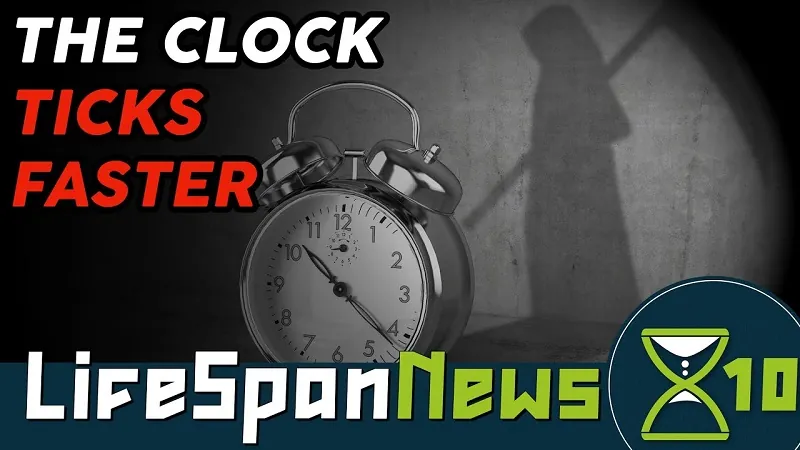This week on Lifespan News, Brent Nally discusses how the GrimAge clock, an accurate predictor of age of death, shows that major depression accelerates aging. We also bring up the NIH’s launch of a large-scale project to study senescent cells, research on the pace of aging, brain cells and DNA repair, and how selenium supplementation seems to protect against obesity in mice.
Further Reading
GrimAge is accelerated in major depression
Pace of Aging (“Youthfulness begins in youth”)
SenNet: The NIH Large-Scale Cellular Senescence Initiative
Selenium Supplements Protect Against Obesity in Mice
How brain cells repair their DNA reveals ‘hot spots’ of aging and disease
Script
Is depression associated with accelerated cellular aging? Stay tuned to find out. We’ll have this story plus four other stories in this episode of Lifespan News.
Welcome to Lifespan News on X10, your source for longevity science updates. I’m your host, Brent Nally. We encourage you to check the description below for links to these stories.
Continuing with our first story, GrimAge is accelerated in major depression. Scientists at University of California San Francisco, or UCSF, found that cells from people with Major Depressive Disorder, or MDD, had a significantly higher score on the GrimAge clock which is a mathematical algorithm designed to predict an individual’s remaining lifespan based on cellular methylation patterns. MDD affects about 300 million people globally, according to the World Health Organization. The researchers collected blood samples from 49 individuals with MDD who were unmedicated prior to the study and 60 healthy control subjects of the same chronological age. Although the individuals with MDD showed no outward signs of age-related pathology, the GrimAge score of their cells predicted that they were about two years older on average. “This is shifting the way we understand depression, from a purely mental or psychiatric disease, limited to processes in the brain, to a whole-body disease,” said Katerina Protsenko, a medical student at UCSF and lead author of the study. “This should fundamentally alter the way we approach depression and how we think about it – as a part of overall health.”
For our next story, ‘Pace of Aging’ shows that “Youthfulness begins in youth”. An international research team used longitudinal data to model individual rates of biological aging. The researchers found that important aging outcomes can already be predicted at middle age. The researchers studied a cohort of 1,037 infants born the same year and followed to age 45. The researchers created a ‘Pace of Aging’ score by tracking declining function in 19 biomarkers indexing the cardiovascular, metabolic, renal, immune, dental and pulmonary systems across ages 26, 32, 38 and 45. The resulting metric ranged from 0.4 biological years for every chronological year of aging to 2.44 biological years for every chronological year: which is a sixfold range already by middle age. Participants with a higher Pace of Aging in 2019 (at age 45) had more cognitive difficulties, signs of advanced brain aging, diminished sensory – motor functions, older appearances and more pessimistic perceptions of aging. The researchers wrote that “a faster rate of biological aging, assessed across several organ systems, throughout midlife, is associated with several measures of functional impairment and frailty risk that have established links to morbidity and mortality in older adults. The breadth of these associations is consistent with the geroscience hypothesis depicting accelerated aging as a common cause of age-related chronic disease.” The researchers also raise the value of effective aging biomarkers for setting policy, an intriguing idea that we haven’t seen discussed much: “Widespread application of biological aging measures could represent an alternative to using birth dates when determining the allocation of healthcare and financial support for those suffering from the sequelae of aging.”
By the way, Lifespan News is released every Tuesday at noon Eastern time, while our other science and advocacy X10 videos are released every other Monday also at noon Eastern time. We encourage you to subscribe to our X10 YouTube channel. Once you’re subscribed, be sure to click the notification bell and select “All Notifications” to ensure you don’t miss any videos. Now back to the news.
The United States National Institutes of Health, or NIH, has recently announced a major project related to cellular senescence: SenNet, the Cellular Senescence Network. The goal of SenNet is to identify and characterize senescent cells in human tissue and their role in health, disease, and lifespan at single-cell resolution. The project aims to create an atlas of senescent cells and develop technologies to identify, characterize, and modify senescent cells. While cellular senescence is a known hallmark of aging and its role in the aging of model organisms has been extensively studied, much less is known about senescent cells in humans. According to two prominent experts Lifespan.io interviewed on the subject, this initiative is extremely promising, though they disagree on pros and cons. You can find the interview linked in the description below. In the past, the NIH didn’t pay much attention to the role that aging plays in the development of diseases and disabilities, but this initiative might signal a paradigm shift for the NIH.
Moving on, selenium supplements protect against obesity in mice. A new study has shown that selenium supplementation protects mice against the effects of a high-fat diet, obtaining results similar to methionine restriction, or MR. Methionine is an essential amino acid, and its restriction is known to have similar beneficial effects as caloric restriction. The study showed that MR increases FGF21, which positively affects longevity, and decreases IGF-1, which is a hormone with mixed effects in humans. Different effects observed in the experiment were surprisingly sex-specific; however, selenium supplementation produced MR-like effects in both sexes. It should be noted that, while selenium is a micronutrient in small doses, selenium is a poison at higher concentrations, and we don’t know for a fact whether the effects observed in this study apply to humans or not.
For our final story, ‘Hot spots’ of aging and disease are revealed by how brain cells repair their DNA. Neurons lack the ability to replicate their DNA, so neurons are constantly working to repair their genome damage. A new study by Salk scientists finds that these repairs are not random, but instead focus on protecting certain genetic ‘hot spots’ that appear to play a critical role in neural identity and function. The researchers produced neurons from stem cells and fed them synthetic nucleosides. These artificial nucleosides could be found via DNA sequencing and imaged, showing where the neurons used them to make repairs to DNA that was damaged by normal cellular processes. “We flipped the paradigm from looking for damage to looking for repair, and that’s why we were able to find these hot spots,” says co-first and co-corresponding author Dylan Reid, a former Salk postdoctoral scholar and now a fellow at Vertex Pharmaceuticals. The authors found approximately 65,000 hot spots that covered around 2 percent of the neuronal genome. Proteomic analysis revealed that the hotspots were enriched in splicing-related proteins. “What we saw was incredibly sharp, well-defined regions of repair; very focused areas that were substantially higher than background levels,” says Reid. “The proteins that sit on these ‘hot spots’ are implicated in neurodegenerative disease, and the sites are also linked to aging.”
That’s all the news for this video. Before you go, there’s a few quick, free and simple things that you can do to help us solve the human aging problem. If you haven’t already, please make sure to like this video. Share this video on your social media. Please make sure that you’re subscribed with the bell turned to “All Notifications” to ensure you don’t miss any videos. Is there a recent life extension story that you think we should have included in one of our recent videos but haven’t yet? And which of the stories from this video excited you the most? Let us know what you think in the comments below. We really appreciate it and we look forward to seeing you in the next video at least as healthy as you are now.




